Marketing Essentials for Travel and Tourism
VerifiedAdded on 2022/12/29
|13
|3996
|39
AI Summary
This document discusses the key roles and responsibilities of marketing in the travel and tourism industry. It explores how marketing functions relate to the wider organizational context and compares the marketing strategies of different tourism organizations. The document also includes a basic marketing plan for a travel and tourism organization.
Contribute Materials
Your contribution can guide someone’s learning journey. Share your
documents today.
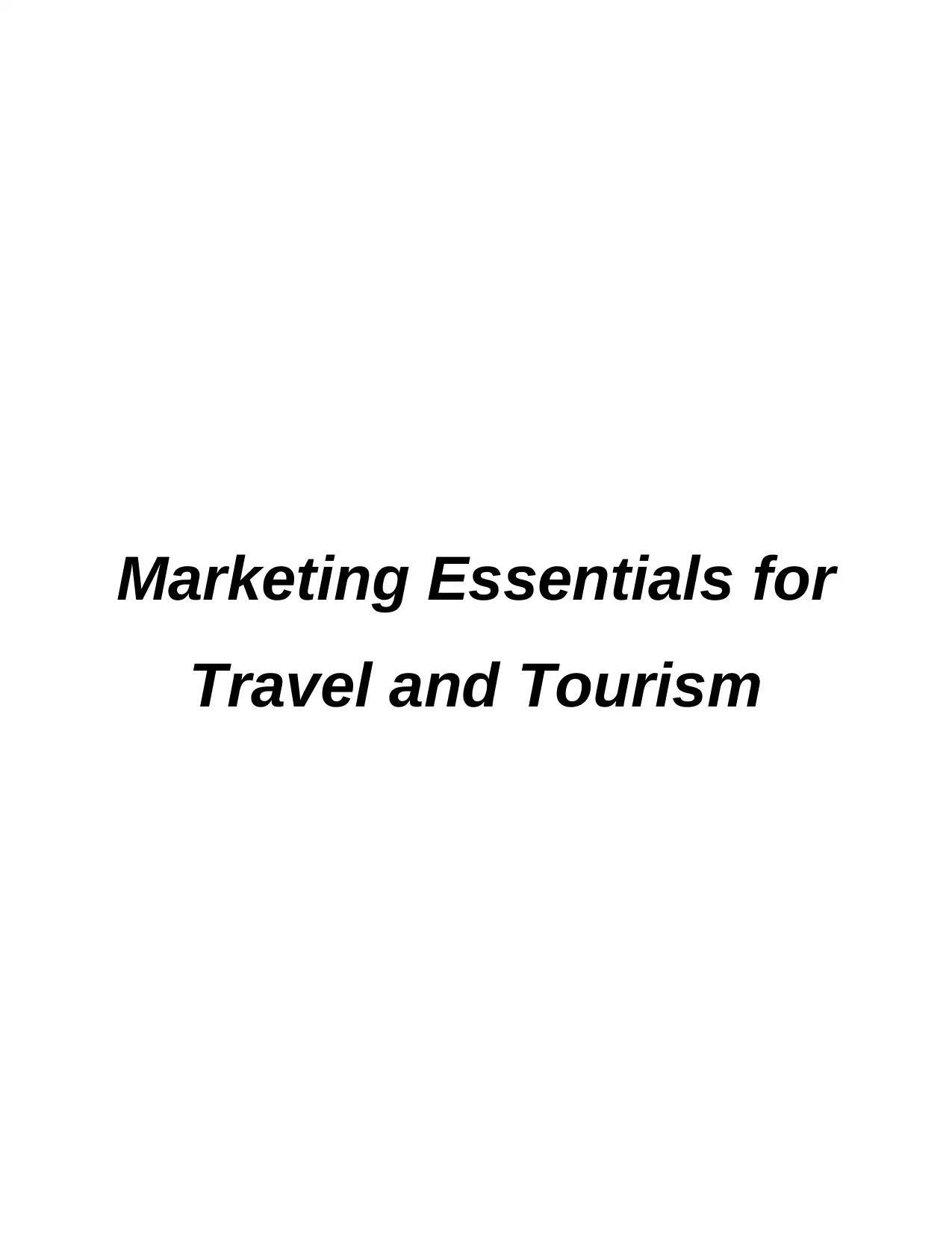
Marketing Essentials for
Travel and Tourism
Travel and Tourism
Secure Best Marks with AI Grader
Need help grading? Try our AI Grader for instant feedback on your assignments.
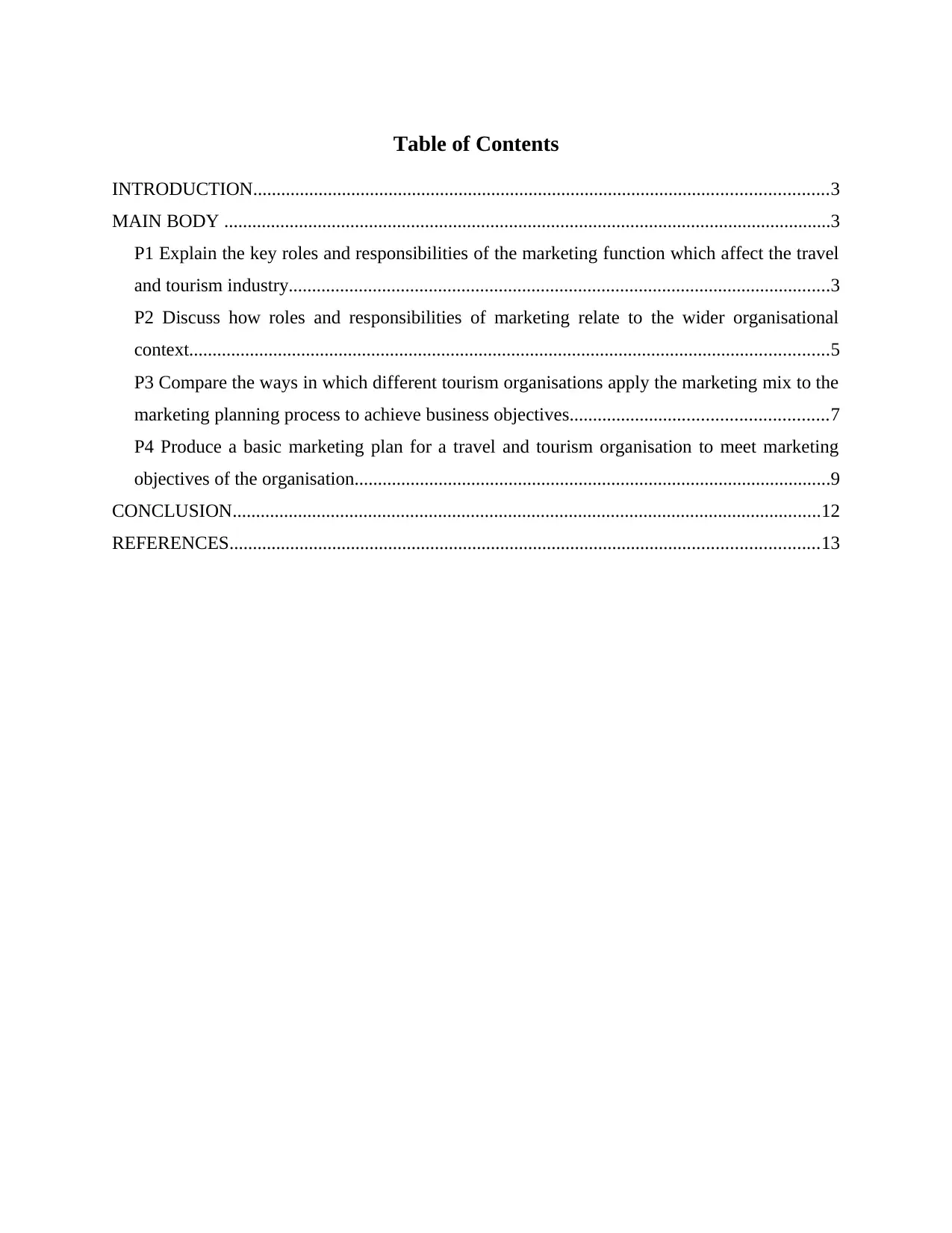
Table of Contents
INTRODUCTION...........................................................................................................................3
MAIN BODY ..................................................................................................................................3
P1 Explain the key roles and responsibilities of the marketing function which affect the travel
and tourism industry....................................................................................................................3
P2 Discuss how roles and responsibilities of marketing relate to the wider organisational
context.........................................................................................................................................5
P3 Compare the ways in which different tourism organisations apply the marketing mix to the
marketing planning process to achieve business objectives.......................................................7
P4 Produce a basic marketing plan for a travel and tourism organisation to meet marketing
objectives of the organisation......................................................................................................9
CONCLUSION..............................................................................................................................12
REFERENCES..............................................................................................................................13
INTRODUCTION...........................................................................................................................3
MAIN BODY ..................................................................................................................................3
P1 Explain the key roles and responsibilities of the marketing function which affect the travel
and tourism industry....................................................................................................................3
P2 Discuss how roles and responsibilities of marketing relate to the wider organisational
context.........................................................................................................................................5
P3 Compare the ways in which different tourism organisations apply the marketing mix to the
marketing planning process to achieve business objectives.......................................................7
P4 Produce a basic marketing plan for a travel and tourism organisation to meet marketing
objectives of the organisation......................................................................................................9
CONCLUSION..............................................................................................................................12
REFERENCES..............................................................................................................................13
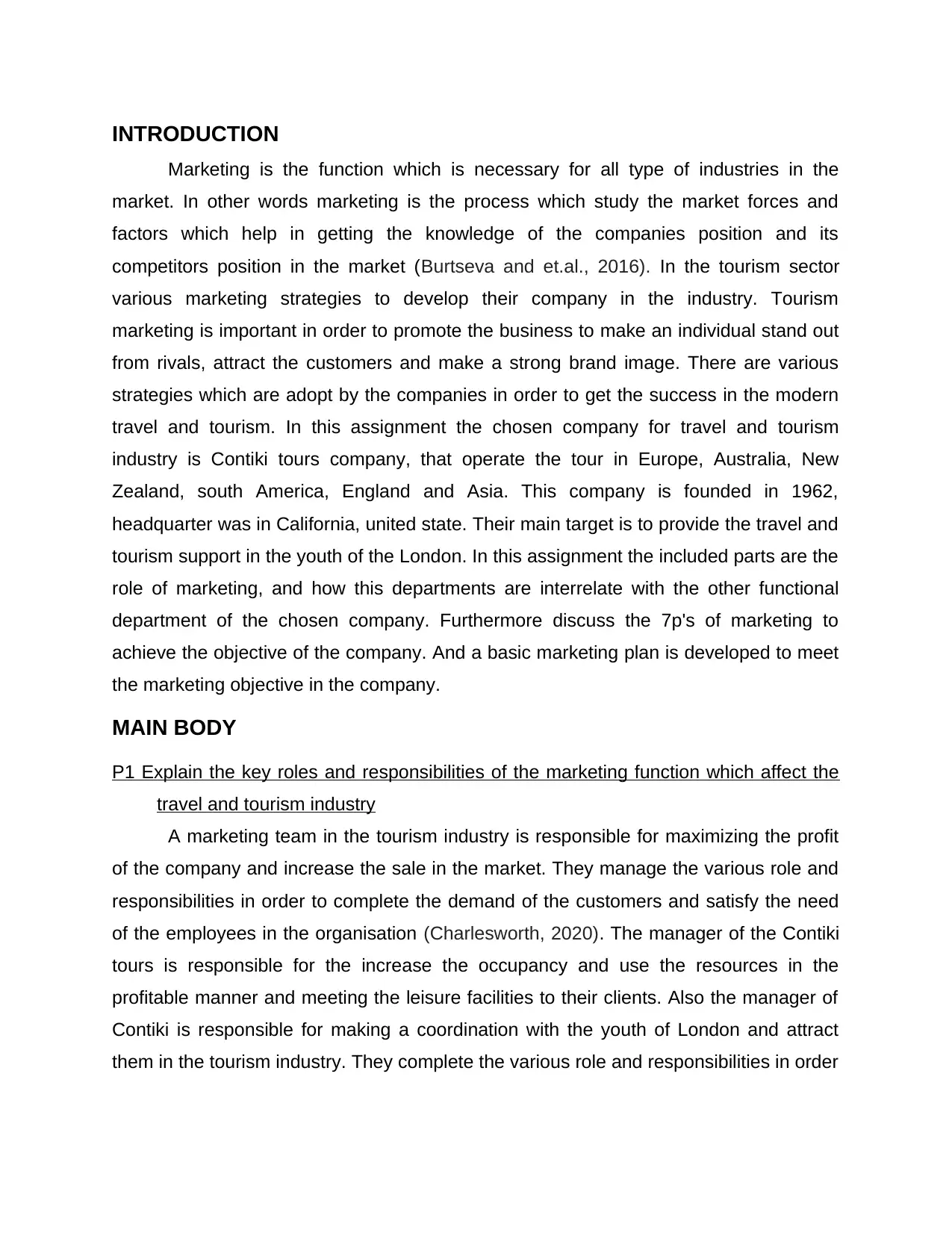
INTRODUCTION
Marketing is the function which is necessary for all type of industries in the
market. In other words marketing is the process which study the market forces and
factors which help in getting the knowledge of the companies position and its
competitors position in the market (Burtseva and et.al., 2016). In the tourism sector
various marketing strategies to develop their company in the industry. Tourism
marketing is important in order to promote the business to make an individual stand out
from rivals, attract the customers and make a strong brand image. There are various
strategies which are adopt by the companies in order to get the success in the modern
travel and tourism. In this assignment the chosen company for travel and tourism
industry is Contiki tours company, that operate the tour in Europe, Australia, New
Zealand, south America, England and Asia. This company is founded in 1962,
headquarter was in California, united state. Their main target is to provide the travel and
tourism support in the youth of the London. In this assignment the included parts are the
role of marketing, and how this departments are interrelate with the other functional
department of the chosen company. Furthermore discuss the 7p's of marketing to
achieve the objective of the company. And a basic marketing plan is developed to meet
the marketing objective in the company.
MAIN BODY
P1 Explain the key roles and responsibilities of the marketing function which affect the
travel and tourism industry
A marketing team in the tourism industry is responsible for maximizing the profit
of the company and increase the sale in the market. They manage the various role and
responsibilities in order to complete the demand of the customers and satisfy the need
of the employees in the organisation (Charlesworth, 2020). The manager of the Contiki
tours is responsible for the increase the occupancy and use the resources in the
profitable manner and meeting the leisure facilities to their clients. Also the manager of
Contiki is responsible for making a coordination with the youth of London and attract
them in the tourism industry. They complete the various role and responsibilities in order
Marketing is the function which is necessary for all type of industries in the
market. In other words marketing is the process which study the market forces and
factors which help in getting the knowledge of the companies position and its
competitors position in the market (Burtseva and et.al., 2016). In the tourism sector
various marketing strategies to develop their company in the industry. Tourism
marketing is important in order to promote the business to make an individual stand out
from rivals, attract the customers and make a strong brand image. There are various
strategies which are adopt by the companies in order to get the success in the modern
travel and tourism. In this assignment the chosen company for travel and tourism
industry is Contiki tours company, that operate the tour in Europe, Australia, New
Zealand, south America, England and Asia. This company is founded in 1962,
headquarter was in California, united state. Their main target is to provide the travel and
tourism support in the youth of the London. In this assignment the included parts are the
role of marketing, and how this departments are interrelate with the other functional
department of the chosen company. Furthermore discuss the 7p's of marketing to
achieve the objective of the company. And a basic marketing plan is developed to meet
the marketing objective in the company.
MAIN BODY
P1 Explain the key roles and responsibilities of the marketing function which affect the
travel and tourism industry
A marketing team in the tourism industry is responsible for maximizing the profit
of the company and increase the sale in the market. They manage the various role and
responsibilities in order to complete the demand of the customers and satisfy the need
of the employees in the organisation (Charlesworth, 2020). The manager of the Contiki
tours is responsible for the increase the occupancy and use the resources in the
profitable manner and meeting the leisure facilities to their clients. Also the manager of
Contiki is responsible for making a coordination with the youth of London and attract
them in the tourism industry. They complete the various role and responsibilities in order
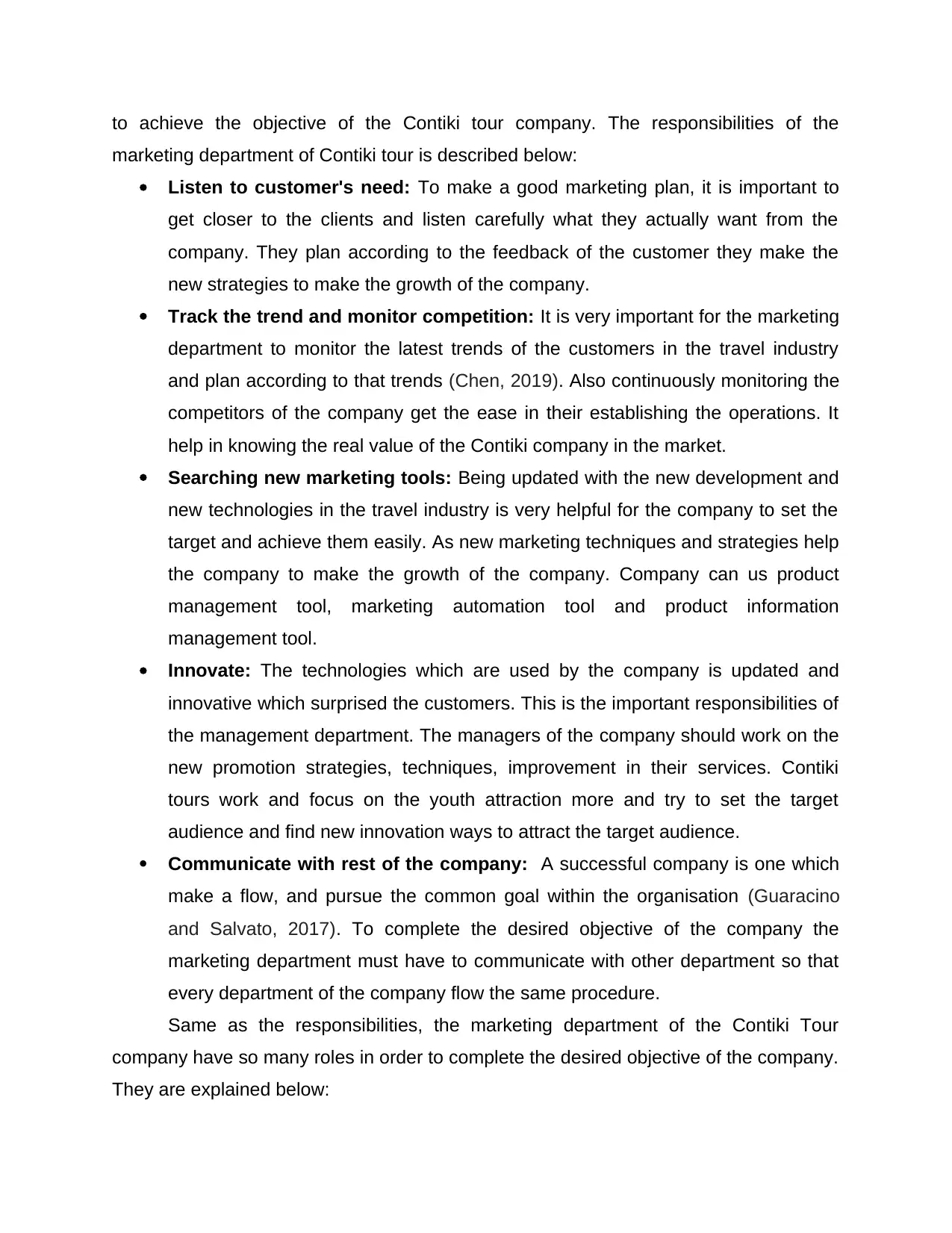
to achieve the objective of the Contiki tour company. The responsibilities of the
marketing department of Contiki tour is described below:
Listen to customer's need: To make a good marketing plan, it is important to
get closer to the clients and listen carefully what they actually want from the
company. They plan according to the feedback of the customer they make the
new strategies to make the growth of the company.
Track the trend and monitor competition: It is very important for the marketing
department to monitor the latest trends of the customers in the travel industry
and plan according to that trends (Chen, 2019). Also continuously monitoring the
competitors of the company get the ease in their establishing the operations. It
help in knowing the real value of the Contiki company in the market.
Searching new marketing tools: Being updated with the new development and
new technologies in the travel industry is very helpful for the company to set the
target and achieve them easily. As new marketing techniques and strategies help
the company to make the growth of the company. Company can us product
management tool, marketing automation tool and product information
management tool.
Innovate: The technologies which are used by the company is updated and
innovative which surprised the customers. This is the important responsibilities of
the management department. The managers of the company should work on the
new promotion strategies, techniques, improvement in their services. Contiki
tours work and focus on the youth attraction more and try to set the target
audience and find new innovation ways to attract the target audience.
Communicate with rest of the company: A successful company is one which
make a flow, and pursue the common goal within the organisation (Guaracino
and Salvato, 2017). To complete the desired objective of the company the
marketing department must have to communicate with other department so that
every department of the company flow the same procedure.
Same as the responsibilities, the marketing department of the Contiki Tour
company have so many roles in order to complete the desired objective of the company.
They are explained below:
marketing department of Contiki tour is described below:
Listen to customer's need: To make a good marketing plan, it is important to
get closer to the clients and listen carefully what they actually want from the
company. They plan according to the feedback of the customer they make the
new strategies to make the growth of the company.
Track the trend and monitor competition: It is very important for the marketing
department to monitor the latest trends of the customers in the travel industry
and plan according to that trends (Chen, 2019). Also continuously monitoring the
competitors of the company get the ease in their establishing the operations. It
help in knowing the real value of the Contiki company in the market.
Searching new marketing tools: Being updated with the new development and
new technologies in the travel industry is very helpful for the company to set the
target and achieve them easily. As new marketing techniques and strategies help
the company to make the growth of the company. Company can us product
management tool, marketing automation tool and product information
management tool.
Innovate: The technologies which are used by the company is updated and
innovative which surprised the customers. This is the important responsibilities of
the management department. The managers of the company should work on the
new promotion strategies, techniques, improvement in their services. Contiki
tours work and focus on the youth attraction more and try to set the target
audience and find new innovation ways to attract the target audience.
Communicate with rest of the company: A successful company is one which
make a flow, and pursue the common goal within the organisation (Guaracino
and Salvato, 2017). To complete the desired objective of the company the
marketing department must have to communicate with other department so that
every department of the company flow the same procedure.
Same as the responsibilities, the marketing department of the Contiki Tour
company have so many roles in order to complete the desired objective of the company.
They are explained below:
Secure Best Marks with AI Grader
Need help grading? Try our AI Grader for instant feedback on your assignments.
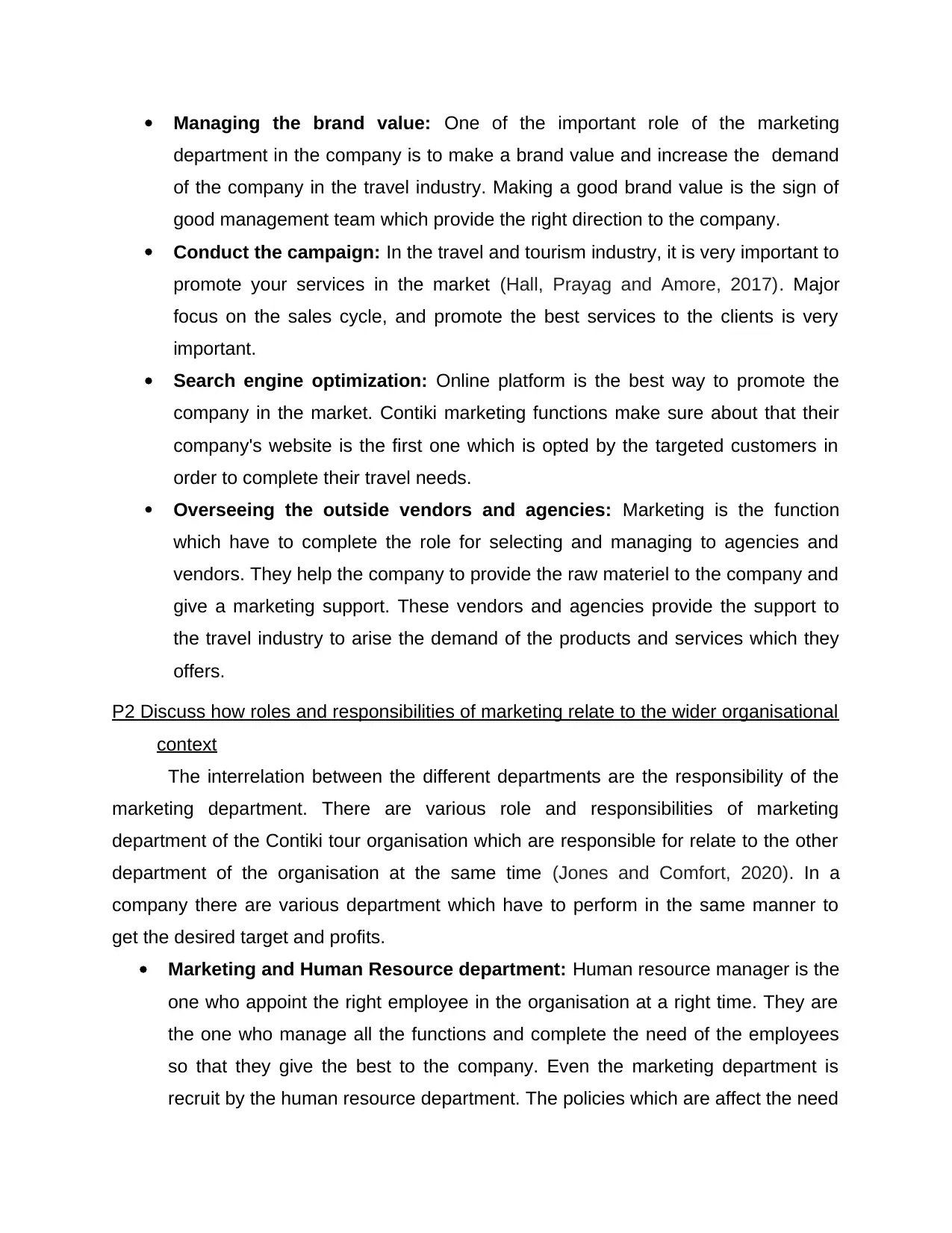
Managing the brand value: One of the important role of the marketing
department in the company is to make a brand value and increase the demand
of the company in the travel industry. Making a good brand value is the sign of
good management team which provide the right direction to the company.
Conduct the campaign: In the travel and tourism industry, it is very important to
promote your services in the market (Hall, Prayag and Amore, 2017). Major
focus on the sales cycle, and promote the best services to the clients is very
important.
Search engine optimization: Online platform is the best way to promote the
company in the market. Contiki marketing functions make sure about that their
company's website is the first one which is opted by the targeted customers in
order to complete their travel needs.
Overseeing the outside vendors and agencies: Marketing is the function
which have to complete the role for selecting and managing to agencies and
vendors. They help the company to provide the raw materiel to the company and
give a marketing support. These vendors and agencies provide the support to
the travel industry to arise the demand of the products and services which they
offers.
P2 Discuss how roles and responsibilities of marketing relate to the wider organisational
context
The interrelation between the different departments are the responsibility of the
marketing department. There are various role and responsibilities of marketing
department of the Contiki tour organisation which are responsible for relate to the other
department of the organisation at the same time (Jones and Comfort, 2020). In a
company there are various department which have to perform in the same manner to
get the desired target and profits.
Marketing and Human Resource department: Human resource manager is the
one who appoint the right employee in the organisation at a right time. They are
the one who manage all the functions and complete the need of the employees
so that they give the best to the company. Even the marketing department is
recruit by the human resource department. The policies which are affect the need
department in the company is to make a brand value and increase the demand
of the company in the travel industry. Making a good brand value is the sign of
good management team which provide the right direction to the company.
Conduct the campaign: In the travel and tourism industry, it is very important to
promote your services in the market (Hall, Prayag and Amore, 2017). Major
focus on the sales cycle, and promote the best services to the clients is very
important.
Search engine optimization: Online platform is the best way to promote the
company in the market. Contiki marketing functions make sure about that their
company's website is the first one which is opted by the targeted customers in
order to complete their travel needs.
Overseeing the outside vendors and agencies: Marketing is the function
which have to complete the role for selecting and managing to agencies and
vendors. They help the company to provide the raw materiel to the company and
give a marketing support. These vendors and agencies provide the support to
the travel industry to arise the demand of the products and services which they
offers.
P2 Discuss how roles and responsibilities of marketing relate to the wider organisational
context
The interrelation between the different departments are the responsibility of the
marketing department. There are various role and responsibilities of marketing
department of the Contiki tour organisation which are responsible for relate to the other
department of the organisation at the same time (Jones and Comfort, 2020). In a
company there are various department which have to perform in the same manner to
get the desired target and profits.
Marketing and Human Resource department: Human resource manager is the
one who appoint the right employee in the organisation at a right time. They are
the one who manage all the functions and complete the need of the employees
so that they give the best to the company. Even the marketing department is
recruit by the human resource department. The policies which are affect the need
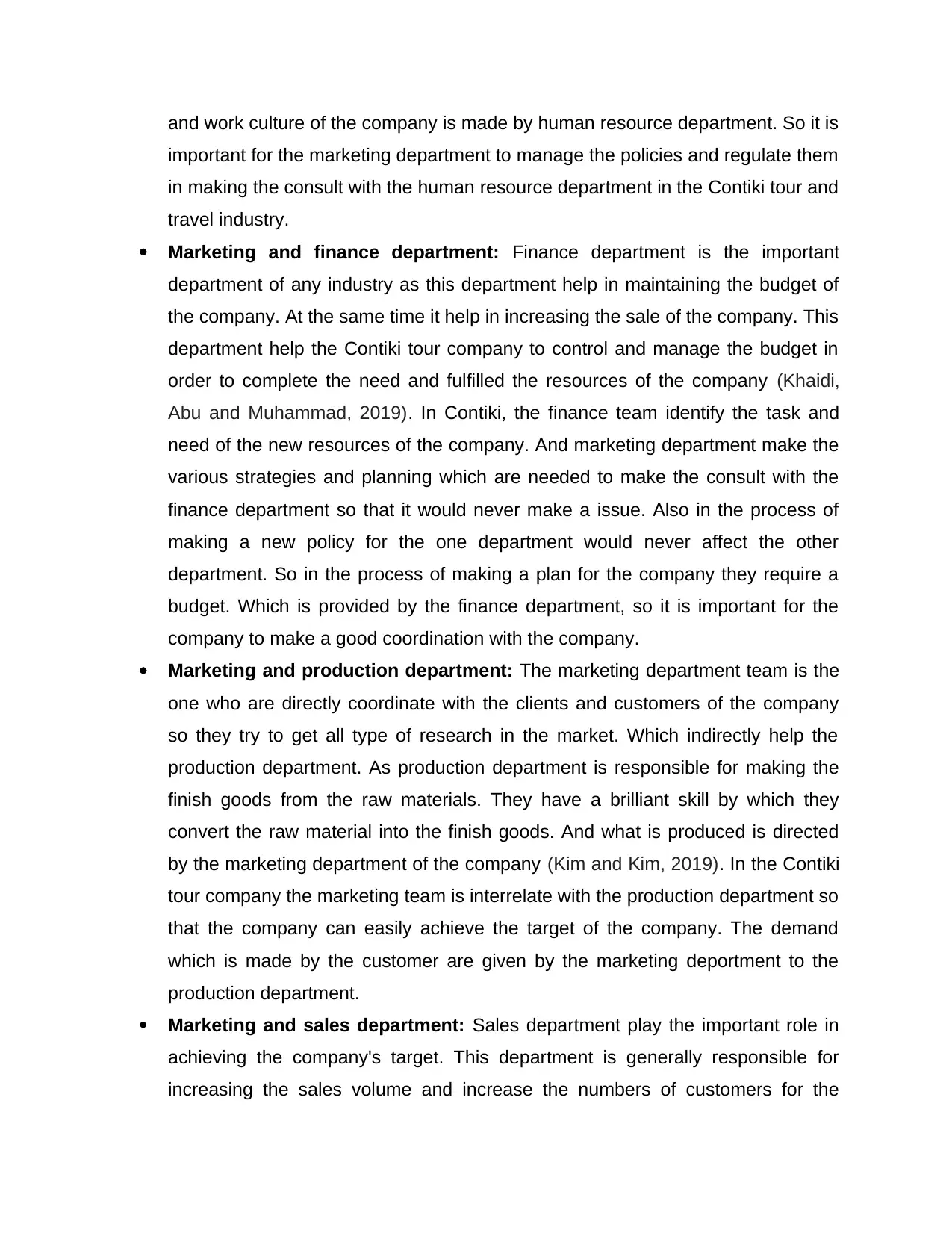
and work culture of the company is made by human resource department. So it is
important for the marketing department to manage the policies and regulate them
in making the consult with the human resource department in the Contiki tour and
travel industry.
Marketing and finance department: Finance department is the important
department of any industry as this department help in maintaining the budget of
the company. At the same time it help in increasing the sale of the company. This
department help the Contiki tour company to control and manage the budget in
order to complete the need and fulfilled the resources of the company (Khaidi,
Abu and Muhammad, 2019). In Contiki, the finance team identify the task and
need of the new resources of the company. And marketing department make the
various strategies and planning which are needed to make the consult with the
finance department so that it would never make a issue. Also in the process of
making a new policy for the one department would never affect the other
department. So in the process of making a plan for the company they require a
budget. Which is provided by the finance department, so it is important for the
company to make a good coordination with the company.
Marketing and production department: The marketing department team is the
one who are directly coordinate with the clients and customers of the company
so they try to get all type of research in the market. Which indirectly help the
production department. As production department is responsible for making the
finish goods from the raw materials. They have a brilliant skill by which they
convert the raw material into the finish goods. And what is produced is directed
by the marketing department of the company (Kim and Kim, 2019). In the Contiki
tour company the marketing team is interrelate with the production department so
that the company can easily achieve the target of the company. The demand
which is made by the customer are given by the marketing deportment to the
production department.
Marketing and sales department: Sales department play the important role in
achieving the company's target. This department is generally responsible for
increasing the sales volume and increase the numbers of customers for the
important for the marketing department to manage the policies and regulate them
in making the consult with the human resource department in the Contiki tour and
travel industry.
Marketing and finance department: Finance department is the important
department of any industry as this department help in maintaining the budget of
the company. At the same time it help in increasing the sale of the company. This
department help the Contiki tour company to control and manage the budget in
order to complete the need and fulfilled the resources of the company (Khaidi,
Abu and Muhammad, 2019). In Contiki, the finance team identify the task and
need of the new resources of the company. And marketing department make the
various strategies and planning which are needed to make the consult with the
finance department so that it would never make a issue. Also in the process of
making a new policy for the one department would never affect the other
department. So in the process of making a plan for the company they require a
budget. Which is provided by the finance department, so it is important for the
company to make a good coordination with the company.
Marketing and production department: The marketing department team is the
one who are directly coordinate with the clients and customers of the company
so they try to get all type of research in the market. Which indirectly help the
production department. As production department is responsible for making the
finish goods from the raw materials. They have a brilliant skill by which they
convert the raw material into the finish goods. And what is produced is directed
by the marketing department of the company (Kim and Kim, 2019). In the Contiki
tour company the marketing team is interrelate with the production department so
that the company can easily achieve the target of the company. The demand
which is made by the customer are given by the marketing deportment to the
production department.
Marketing and sales department: Sales department play the important role in
achieving the company's target. This department is generally responsible for
increasing the sales volume and increase the numbers of customers for the
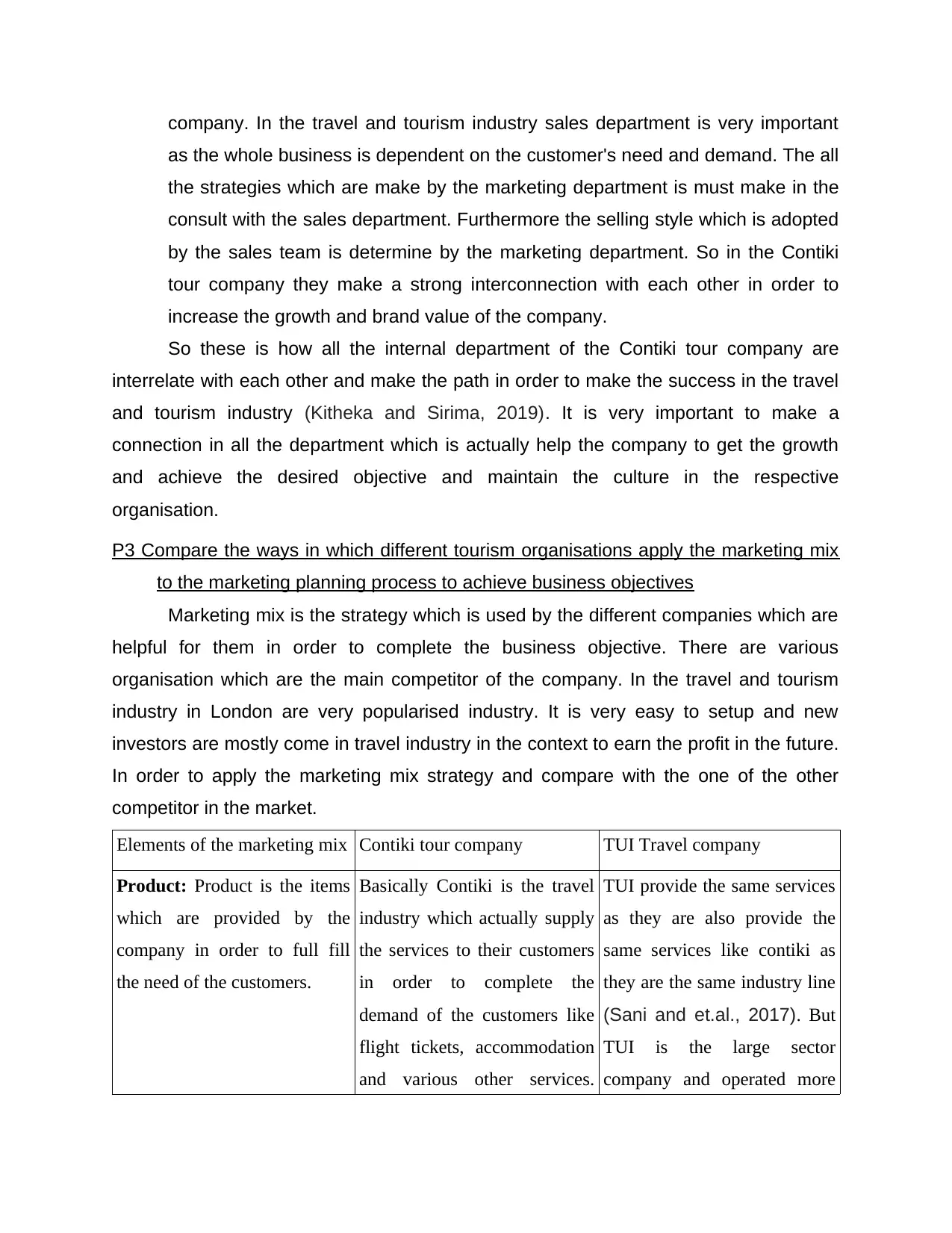
company. In the travel and tourism industry sales department is very important
as the whole business is dependent on the customer's need and demand. The all
the strategies which are make by the marketing department is must make in the
consult with the sales department. Furthermore the selling style which is adopted
by the sales team is determine by the marketing department. So in the Contiki
tour company they make a strong interconnection with each other in order to
increase the growth and brand value of the company.
So these is how all the internal department of the Contiki tour company are
interrelate with each other and make the path in order to make the success in the travel
and tourism industry (Kitheka and Sirima, 2019). It is very important to make a
connection in all the department which is actually help the company to get the growth
and achieve the desired objective and maintain the culture in the respective
organisation.
P3 Compare the ways in which different tourism organisations apply the marketing mix
to the marketing planning process to achieve business objectives
Marketing mix is the strategy which is used by the different companies which are
helpful for them in order to complete the business objective. There are various
organisation which are the main competitor of the company. In the travel and tourism
industry in London are very popularised industry. It is very easy to setup and new
investors are mostly come in travel industry in the context to earn the profit in the future.
In order to apply the marketing mix strategy and compare with the one of the other
competitor in the market.
Elements of the marketing mix Contiki tour company TUI Travel company
Product: Product is the items
which are provided by the
company in order to full fill
the need of the customers.
Basically Contiki is the travel
industry which actually supply
the services to their customers
in order to complete the
demand of the customers like
flight tickets, accommodation
and various other services.
TUI provide the same services
as they are also provide the
same services like contiki as
they are the same industry line
(Sani and et.al., 2017). But
TUI is the large sector
company and operated more
as the whole business is dependent on the customer's need and demand. The all
the strategies which are make by the marketing department is must make in the
consult with the sales department. Furthermore the selling style which is adopted
by the sales team is determine by the marketing department. So in the Contiki
tour company they make a strong interconnection with each other in order to
increase the growth and brand value of the company.
So these is how all the internal department of the Contiki tour company are
interrelate with each other and make the path in order to make the success in the travel
and tourism industry (Kitheka and Sirima, 2019). It is very important to make a
connection in all the department which is actually help the company to get the growth
and achieve the desired objective and maintain the culture in the respective
organisation.
P3 Compare the ways in which different tourism organisations apply the marketing mix
to the marketing planning process to achieve business objectives
Marketing mix is the strategy which is used by the different companies which are
helpful for them in order to complete the business objective. There are various
organisation which are the main competitor of the company. In the travel and tourism
industry in London are very popularised industry. It is very easy to setup and new
investors are mostly come in travel industry in the context to earn the profit in the future.
In order to apply the marketing mix strategy and compare with the one of the other
competitor in the market.
Elements of the marketing mix Contiki tour company TUI Travel company
Product: Product is the items
which are provided by the
company in order to full fill
the need of the customers.
Basically Contiki is the travel
industry which actually supply
the services to their customers
in order to complete the
demand of the customers like
flight tickets, accommodation
and various other services.
TUI provide the same services
as they are also provide the
same services like contiki as
they are the same industry line
(Sani and et.al., 2017). But
TUI is the large sector
company and operated more
Paraphrase This Document
Need a fresh take? Get an instant paraphrase of this document with our AI Paraphraser
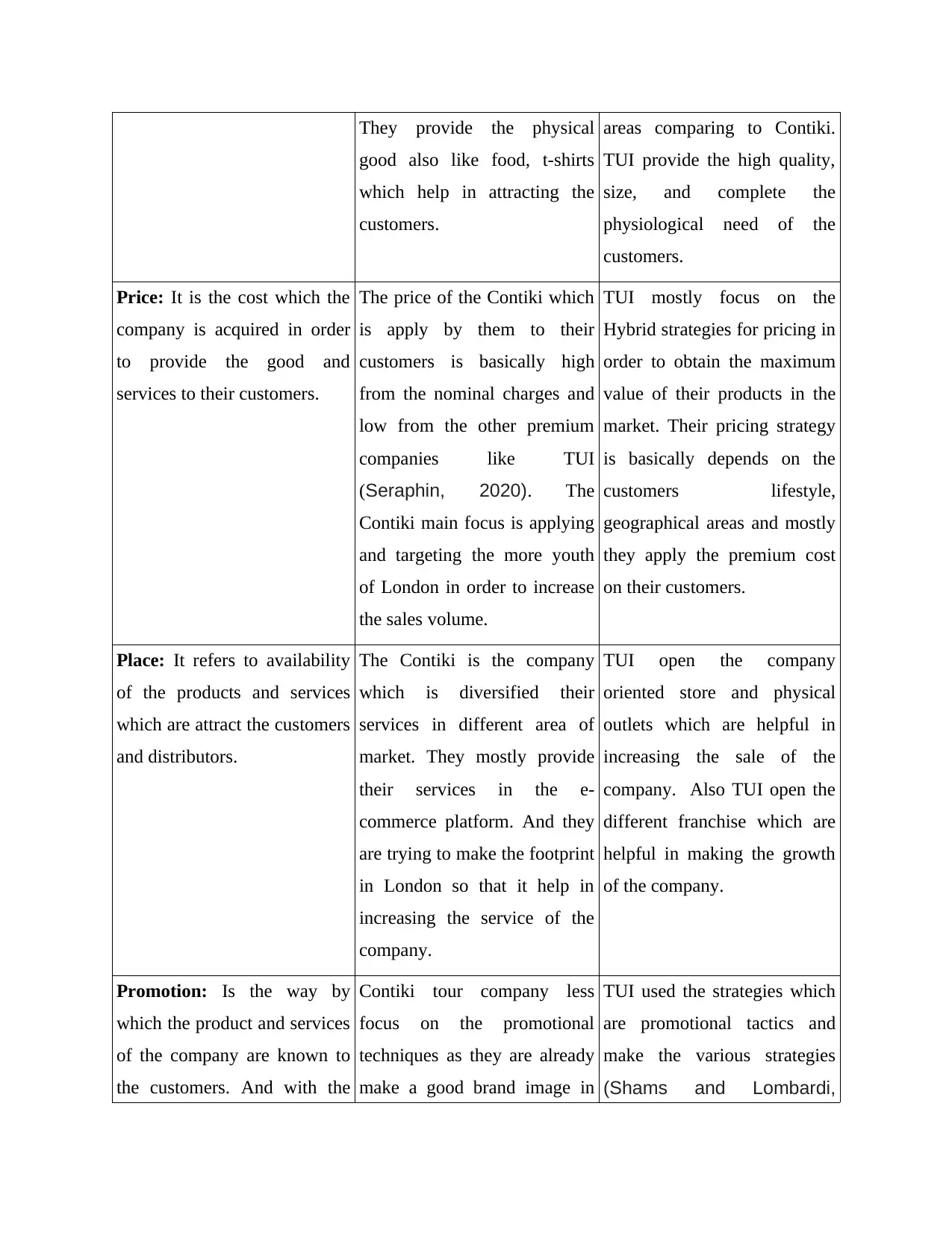
They provide the physical
good also like food, t-shirts
which help in attracting the
customers.
areas comparing to Contiki.
TUI provide the high quality,
size, and complete the
physiological need of the
customers.
Price: It is the cost which the
company is acquired in order
to provide the good and
services to their customers.
The price of the Contiki which
is apply by them to their
customers is basically high
from the nominal charges and
low from the other premium
companies like TUI
(Seraphin, 2020). The
Contiki main focus is applying
and targeting the more youth
of London in order to increase
the sales volume.
TUI mostly focus on the
Hybrid strategies for pricing in
order to obtain the maximum
value of their products in the
market. Their pricing strategy
is basically depends on the
customers lifestyle,
geographical areas and mostly
they apply the premium cost
on their customers.
Place: It refers to availability
of the products and services
which are attract the customers
and distributors.
The Contiki is the company
which is diversified their
services in different area of
market. They mostly provide
their services in the e-
commerce platform. And they
are trying to make the footprint
in London so that it help in
increasing the service of the
company.
TUI open the company
oriented store and physical
outlets which are helpful in
increasing the sale of the
company. Also TUI open the
different franchise which are
helpful in making the growth
of the company.
Promotion: Is the way by
which the product and services
of the company are known to
the customers. And with the
Contiki tour company less
focus on the promotional
techniques as they are already
make a good brand image in
TUI used the strategies which
are promotional tactics and
make the various strategies
(Shams and Lombardi,
good also like food, t-shirts
which help in attracting the
customers.
areas comparing to Contiki.
TUI provide the high quality,
size, and complete the
physiological need of the
customers.
Price: It is the cost which the
company is acquired in order
to provide the good and
services to their customers.
The price of the Contiki which
is apply by them to their
customers is basically high
from the nominal charges and
low from the other premium
companies like TUI
(Seraphin, 2020). The
Contiki main focus is applying
and targeting the more youth
of London in order to increase
the sales volume.
TUI mostly focus on the
Hybrid strategies for pricing in
order to obtain the maximum
value of their products in the
market. Their pricing strategy
is basically depends on the
customers lifestyle,
geographical areas and mostly
they apply the premium cost
on their customers.
Place: It refers to availability
of the products and services
which are attract the customers
and distributors.
The Contiki is the company
which is diversified their
services in different area of
market. They mostly provide
their services in the e-
commerce platform. And they
are trying to make the footprint
in London so that it help in
increasing the service of the
company.
TUI open the company
oriented store and physical
outlets which are helpful in
increasing the sale of the
company. Also TUI open the
different franchise which are
helpful in making the growth
of the company.
Promotion: Is the way by
which the product and services
of the company are known to
the customers. And with the
Contiki tour company less
focus on the promotional
techniques as they are already
make a good brand image in
TUI used the strategies which
are promotional tactics and
make the various strategies
(Shams and Lombardi,
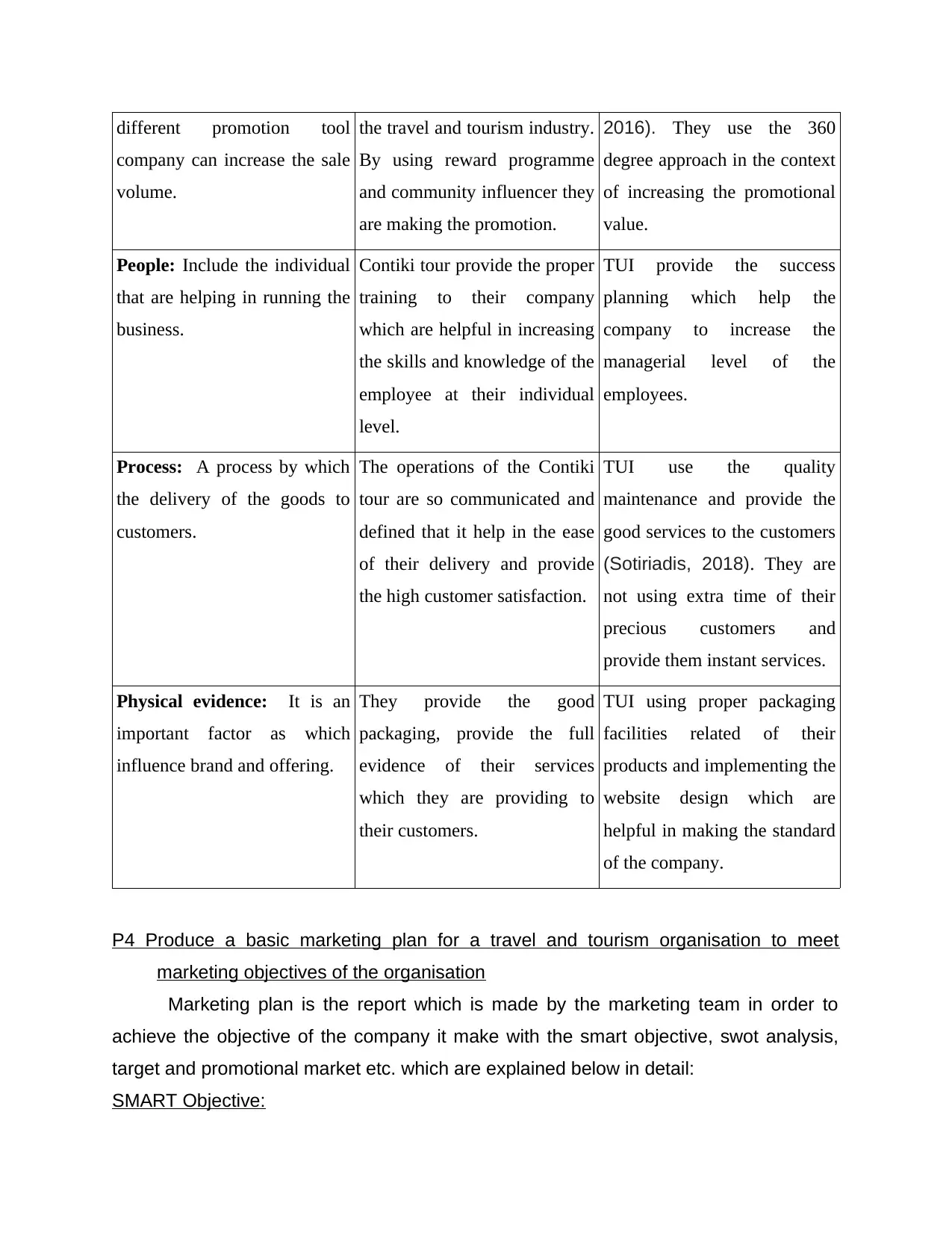
different promotion tool
company can increase the sale
volume.
the travel and tourism industry.
By using reward programme
and community influencer they
are making the promotion.
2016). They use the 360
degree approach in the context
of increasing the promotional
value.
People: Include the individual
that are helping in running the
business.
Contiki tour provide the proper
training to their company
which are helpful in increasing
the skills and knowledge of the
employee at their individual
level.
TUI provide the success
planning which help the
company to increase the
managerial level of the
employees.
Process: A process by which
the delivery of the goods to
customers.
The operations of the Contiki
tour are so communicated and
defined that it help in the ease
of their delivery and provide
the high customer satisfaction.
TUI use the quality
maintenance and provide the
good services to the customers
(Sotiriadis, 2018). They are
not using extra time of their
precious customers and
provide them instant services.
Physical evidence: It is an
important factor as which
influence brand and offering.
They provide the good
packaging, provide the full
evidence of their services
which they are providing to
their customers.
TUI using proper packaging
facilities related of their
products and implementing the
website design which are
helpful in making the standard
of the company.
P4 Produce a basic marketing plan for a travel and tourism organisation to meet
marketing objectives of the organisation
Marketing plan is the report which is made by the marketing team in order to
achieve the objective of the company it make with the smart objective, swot analysis,
target and promotional market etc. which are explained below in detail:
SMART Objective:
company can increase the sale
volume.
the travel and tourism industry.
By using reward programme
and community influencer they
are making the promotion.
2016). They use the 360
degree approach in the context
of increasing the promotional
value.
People: Include the individual
that are helping in running the
business.
Contiki tour provide the proper
training to their company
which are helpful in increasing
the skills and knowledge of the
employee at their individual
level.
TUI provide the success
planning which help the
company to increase the
managerial level of the
employees.
Process: A process by which
the delivery of the goods to
customers.
The operations of the Contiki
tour are so communicated and
defined that it help in the ease
of their delivery and provide
the high customer satisfaction.
TUI use the quality
maintenance and provide the
good services to the customers
(Sotiriadis, 2018). They are
not using extra time of their
precious customers and
provide them instant services.
Physical evidence: It is an
important factor as which
influence brand and offering.
They provide the good
packaging, provide the full
evidence of their services
which they are providing to
their customers.
TUI using proper packaging
facilities related of their
products and implementing the
website design which are
helpful in making the standard
of the company.
P4 Produce a basic marketing plan for a travel and tourism organisation to meet
marketing objectives of the organisation
Marketing plan is the report which is made by the marketing team in order to
achieve the objective of the company it make with the smart objective, swot analysis,
target and promotional market etc. which are explained below in detail:
SMART Objective:
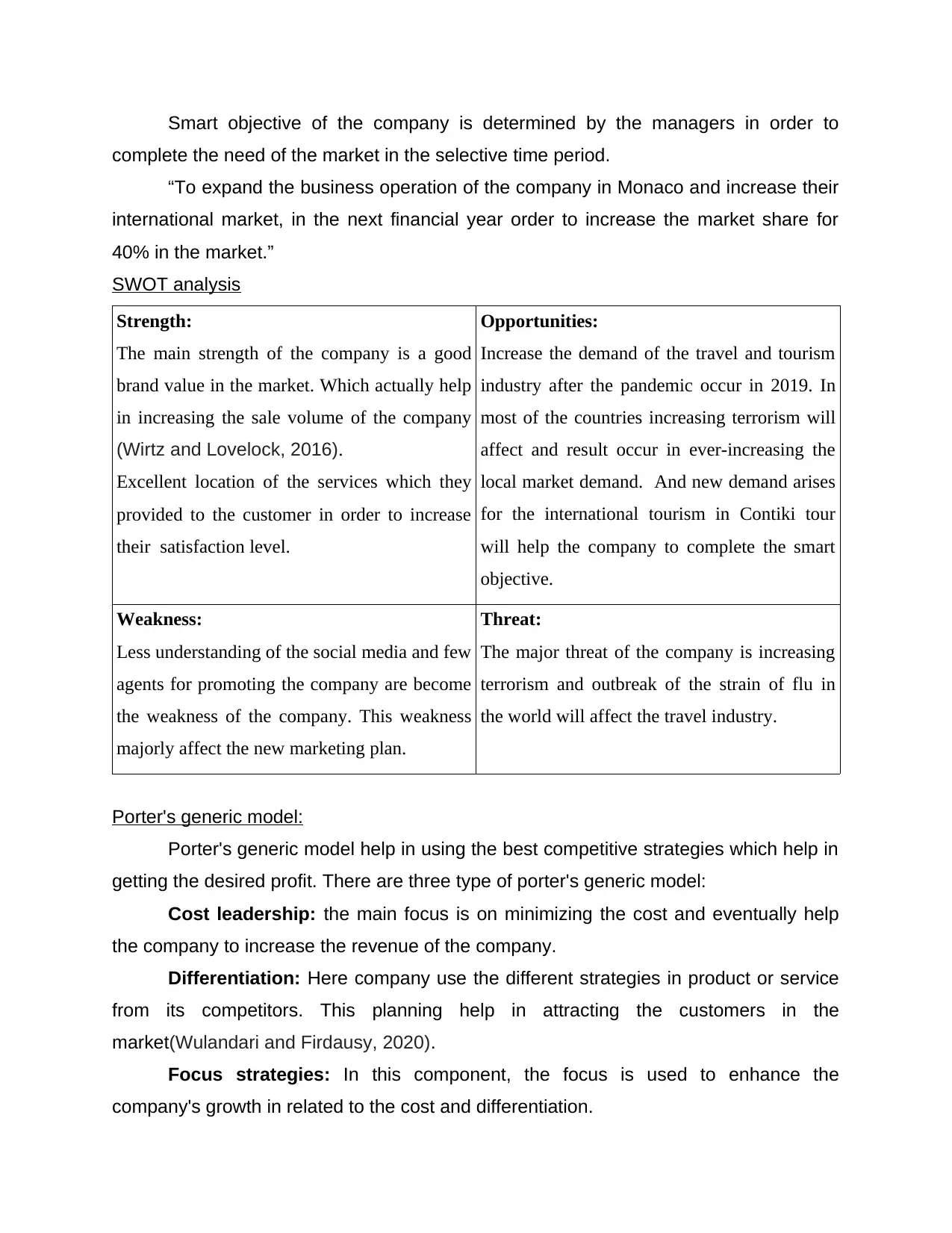
Smart objective of the company is determined by the managers in order to
complete the need of the market in the selective time period.
“To expand the business operation of the company in Monaco and increase their
international market, in the next financial year order to increase the market share for
40% in the market.”
SWOT analysis
Strength:
The main strength of the company is a good
brand value in the market. Which actually help
in increasing the sale volume of the company
(Wirtz and Lovelock, 2016).
Excellent location of the services which they
provided to the customer in order to increase
their satisfaction level.
Opportunities:
Increase the demand of the travel and tourism
industry after the pandemic occur in 2019. In
most of the countries increasing terrorism will
affect and result occur in ever-increasing the
local market demand. And new demand arises
for the international tourism in Contiki tour
will help the company to complete the smart
objective.
Weakness:
Less understanding of the social media and few
agents for promoting the company are become
the weakness of the company. This weakness
majorly affect the new marketing plan.
Threat:
The major threat of the company is increasing
terrorism and outbreak of the strain of flu in
the world will affect the travel industry.
Porter's generic model:
Porter's generic model help in using the best competitive strategies which help in
getting the desired profit. There are three type of porter's generic model:
Cost leadership: the main focus is on minimizing the cost and eventually help
the company to increase the revenue of the company.
Differentiation: Here company use the different strategies in product or service
from its competitors. This planning help in attracting the customers in the
market(Wulandari and Firdausy, 2020).
Focus strategies: In this component, the focus is used to enhance the
company's growth in related to the cost and differentiation.
complete the need of the market in the selective time period.
“To expand the business operation of the company in Monaco and increase their
international market, in the next financial year order to increase the market share for
40% in the market.”
SWOT analysis
Strength:
The main strength of the company is a good
brand value in the market. Which actually help
in increasing the sale volume of the company
(Wirtz and Lovelock, 2016).
Excellent location of the services which they
provided to the customer in order to increase
their satisfaction level.
Opportunities:
Increase the demand of the travel and tourism
industry after the pandemic occur in 2019. In
most of the countries increasing terrorism will
affect and result occur in ever-increasing the
local market demand. And new demand arises
for the international tourism in Contiki tour
will help the company to complete the smart
objective.
Weakness:
Less understanding of the social media and few
agents for promoting the company are become
the weakness of the company. This weakness
majorly affect the new marketing plan.
Threat:
The major threat of the company is increasing
terrorism and outbreak of the strain of flu in
the world will affect the travel industry.
Porter's generic model:
Porter's generic model help in using the best competitive strategies which help in
getting the desired profit. There are three type of porter's generic model:
Cost leadership: the main focus is on minimizing the cost and eventually help
the company to increase the revenue of the company.
Differentiation: Here company use the different strategies in product or service
from its competitors. This planning help in attracting the customers in the
market(Wulandari and Firdausy, 2020).
Focus strategies: In this component, the focus is used to enhance the
company's growth in related to the cost and differentiation.
Secure Best Marks with AI Grader
Need help grading? Try our AI Grader for instant feedback on your assignments.
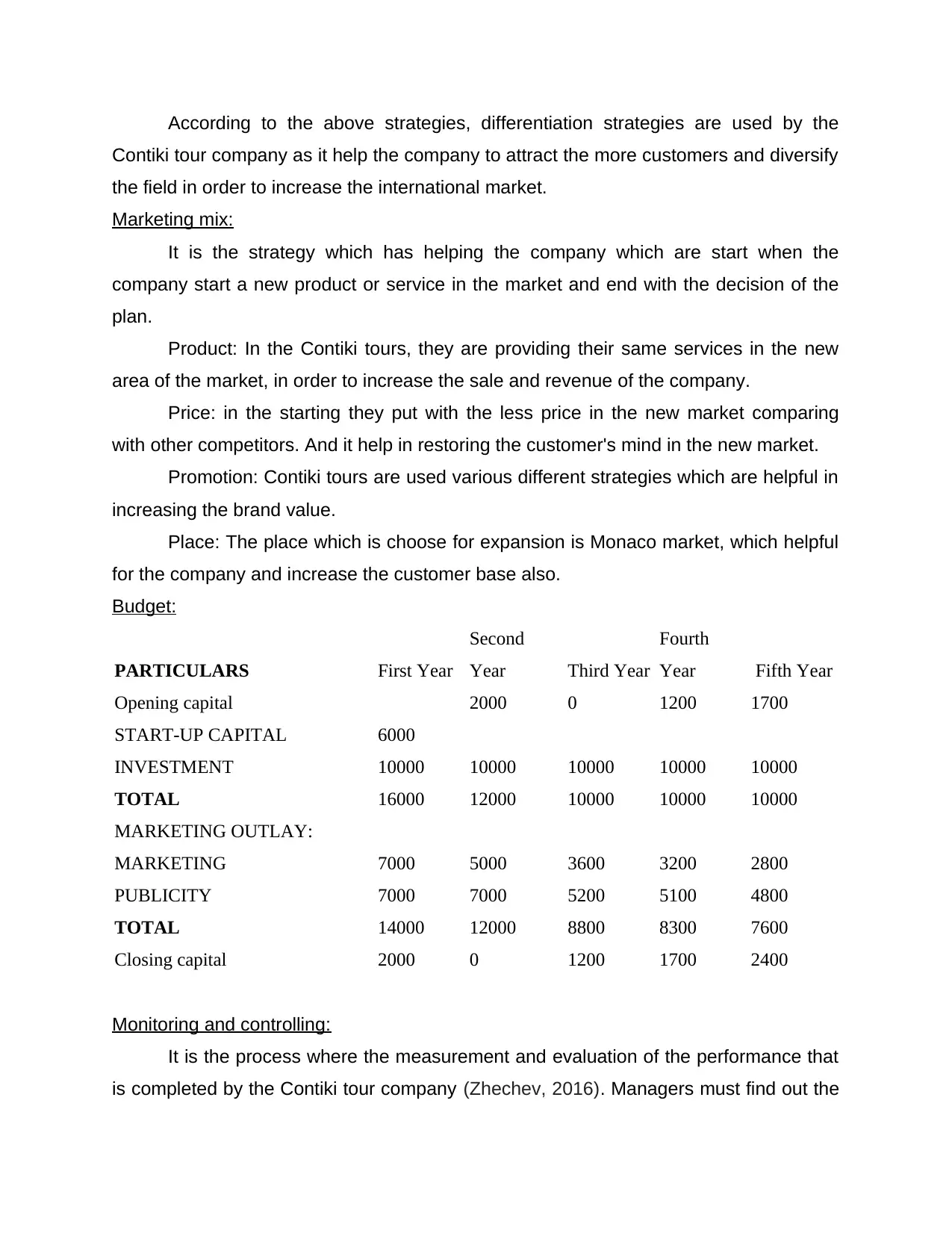
According to the above strategies, differentiation strategies are used by the
Contiki tour company as it help the company to attract the more customers and diversify
the field in order to increase the international market.
Marketing mix:
It is the strategy which has helping the company which are start when the
company start a new product or service in the market and end with the decision of the
plan.
Product: In the Contiki tours, they are providing their same services in the new
area of the market, in order to increase the sale and revenue of the company.
Price: in the starting they put with the less price in the new market comparing
with other competitors. And it help in restoring the customer's mind in the new market.
Promotion: Contiki tours are used various different strategies which are helpful in
increasing the brand value.
Place: The place which is choose for expansion is Monaco market, which helpful
for the company and increase the customer base also.
Budget:
PARTICULARS First Year
Second
Year Third Year
Fourth
Year Fifth Year
Opening capital 2000 0 1200 1700
START-UP CAPITAL 6000
INVESTMENT 10000 10000 10000 10000 10000
TOTAL 16000 12000 10000 10000 10000
MARKETING OUTLAY:
MARKETING 7000 5000 3600 3200 2800
PUBLICITY 7000 7000 5200 5100 4800
TOTAL 14000 12000 8800 8300 7600
Closing capital 2000 0 1200 1700 2400
Monitoring and controlling:
It is the process where the measurement and evaluation of the performance that
is completed by the Contiki tour company (Zhechev, 2016). Managers must find out the
Contiki tour company as it help the company to attract the more customers and diversify
the field in order to increase the international market.
Marketing mix:
It is the strategy which has helping the company which are start when the
company start a new product or service in the market and end with the decision of the
plan.
Product: In the Contiki tours, they are providing their same services in the new
area of the market, in order to increase the sale and revenue of the company.
Price: in the starting they put with the less price in the new market comparing
with other competitors. And it help in restoring the customer's mind in the new market.
Promotion: Contiki tours are used various different strategies which are helpful in
increasing the brand value.
Place: The place which is choose for expansion is Monaco market, which helpful
for the company and increase the customer base also.
Budget:
PARTICULARS First Year
Second
Year Third Year
Fourth
Year Fifth Year
Opening capital 2000 0 1200 1700
START-UP CAPITAL 6000
INVESTMENT 10000 10000 10000 10000 10000
TOTAL 16000 12000 10000 10000 10000
MARKETING OUTLAY:
MARKETING 7000 5000 3600 3200 2800
PUBLICITY 7000 7000 5200 5100 4800
TOTAL 14000 12000 8800 8300 7600
Closing capital 2000 0 1200 1700 2400
Monitoring and controlling:
It is the process where the measurement and evaluation of the performance that
is completed by the Contiki tour company (Zhechev, 2016). Managers must find out the
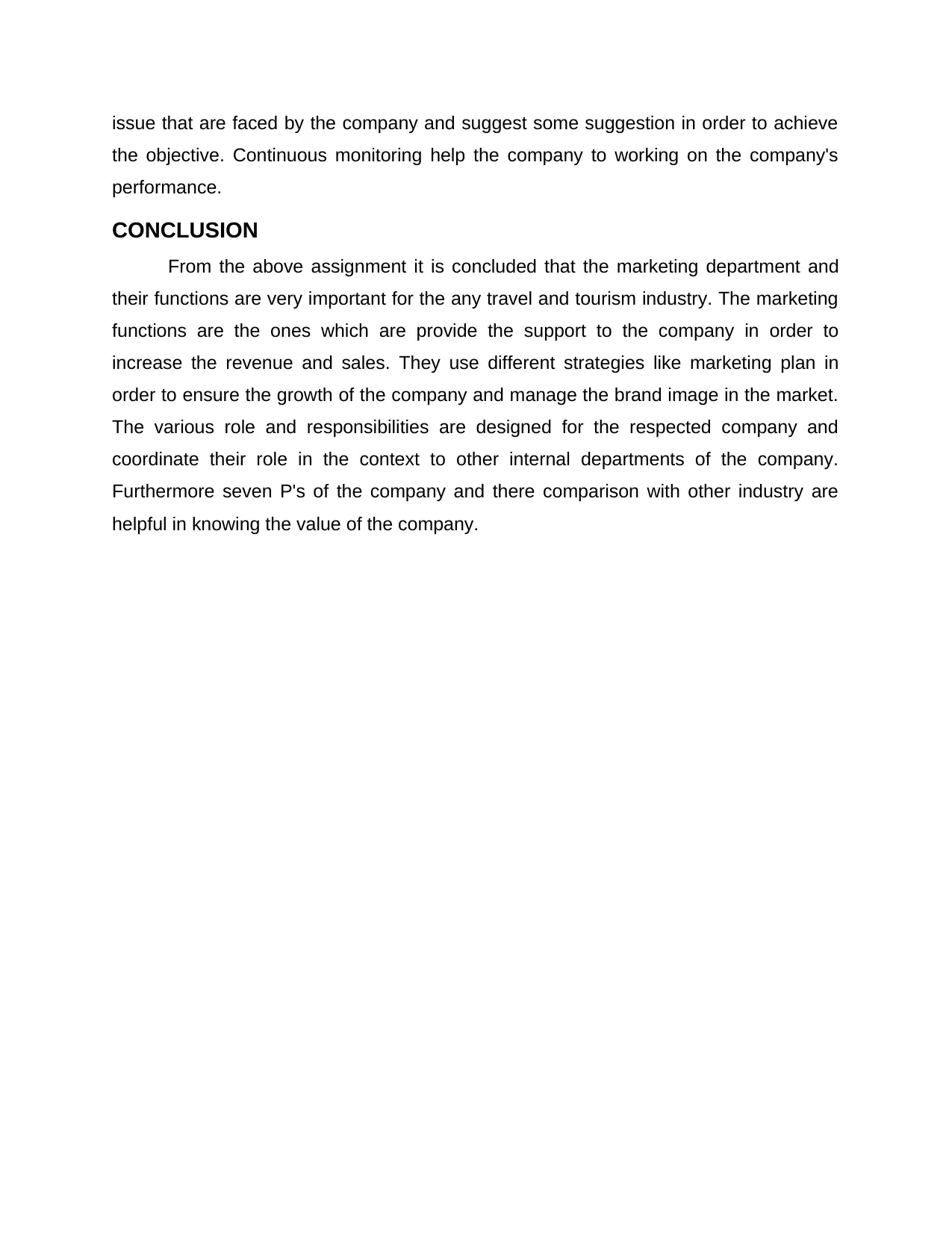
issue that are faced by the company and suggest some suggestion in order to achieve
the objective. Continuous monitoring help the company to working on the company's
performance.
CONCLUSION
From the above assignment it is concluded that the marketing department and
their functions are very important for the any travel and tourism industry. The marketing
functions are the ones which are provide the support to the company in order to
increase the revenue and sales. They use different strategies like marketing plan in
order to ensure the growth of the company and manage the brand image in the market.
The various role and responsibilities are designed for the respected company and
coordinate their role in the context to other internal departments of the company.
Furthermore seven P's of the company and there comparison with other industry are
helpful in knowing the value of the company.
the objective. Continuous monitoring help the company to working on the company's
performance.
CONCLUSION
From the above assignment it is concluded that the marketing department and
their functions are very important for the any travel and tourism industry. The marketing
functions are the ones which are provide the support to the company in order to
increase the revenue and sales. They use different strategies like marketing plan in
order to ensure the growth of the company and manage the brand image in the market.
The various role and responsibilities are designed for the respected company and
coordinate their role in the context to other internal departments of the company.
Furthermore seven P's of the company and there comparison with other industry are
helpful in knowing the value of the company.
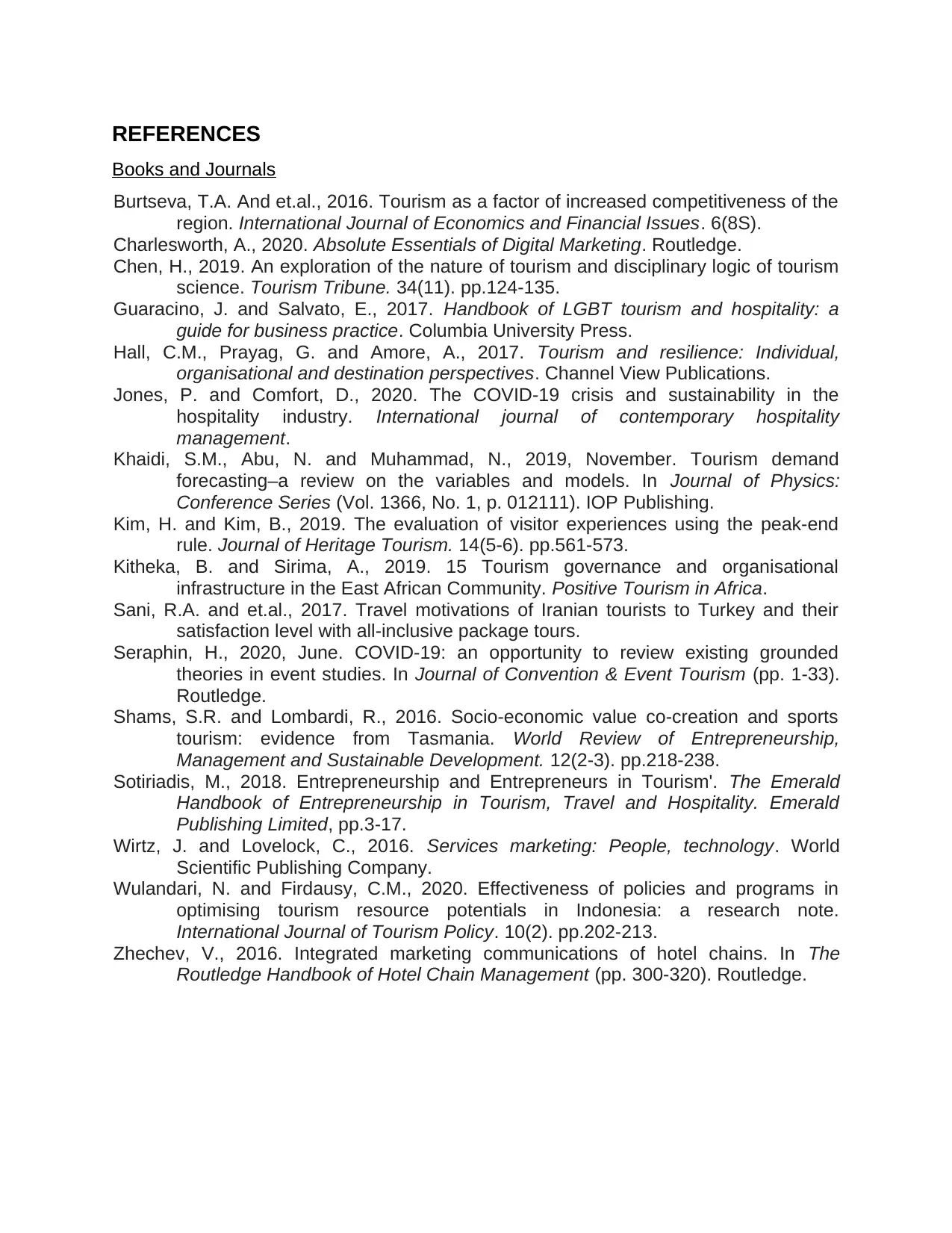
REFERENCES
Books and Journals
Burtseva, T.A. And et.al., 2016. Tourism as a factor of increased competitiveness of the
region. International Journal of Economics and Financial Issues. 6(8S).
Charlesworth, A., 2020. Absolute Essentials of Digital Marketing. Routledge.
Chen, H., 2019. An exploration of the nature of tourism and disciplinary logic of tourism
science. Tourism Tribune. 34(11). pp.124-135.
Guaracino, J. and Salvato, E., 2017. Handbook of LGBT tourism and hospitality: a
guide for business practice. Columbia University Press.
Hall, C.M., Prayag, G. and Amore, A., 2017. Tourism and resilience: Individual,
organisational and destination perspectives. Channel View Publications.
Jones, P. and Comfort, D., 2020. The COVID-19 crisis and sustainability in the
hospitality industry. International journal of contemporary hospitality
management.
Khaidi, S.M., Abu, N. and Muhammad, N., 2019, November. Tourism demand
forecasting–a review on the variables and models. In Journal of Physics:
Conference Series (Vol. 1366, No. 1, p. 012111). IOP Publishing.
Kim, H. and Kim, B., 2019. The evaluation of visitor experiences using the peak-end
rule. Journal of Heritage Tourism. 14(5-6). pp.561-573.
Kitheka, B. and Sirima, A., 2019. 15 Tourism governance and organisational
infrastructure in the East African Community. Positive Tourism in Africa.
Sani, R.A. and et.al., 2017. Travel motivations of Iranian tourists to Turkey and their
satisfaction level with all-inclusive package tours.
Seraphin, H., 2020, June. COVID-19: an opportunity to review existing grounded
theories in event studies. In Journal of Convention & Event Tourism (pp. 1-33).
Routledge.
Shams, S.R. and Lombardi, R., 2016. Socio-economic value co-creation and sports
tourism: evidence from Tasmania. World Review of Entrepreneurship,
Management and Sustainable Development. 12(2-3). pp.218-238.
Sotiriadis, M., 2018. Entrepreneurship and Entrepreneurs in Tourism'. The Emerald
Handbook of Entrepreneurship in Tourism, Travel and Hospitality. Emerald
Publishing Limited, pp.3-17.
Wirtz, J. and Lovelock, C., 2016. Services marketing: People, technology. World
Scientific Publishing Company.
Wulandari, N. and Firdausy, C.M., 2020. Effectiveness of policies and programs in
optimising tourism resource potentials in Indonesia: a research note.
International Journal of Tourism Policy. 10(2). pp.202-213.
Zhechev, V., 2016. Integrated marketing communications of hotel chains. In The
Routledge Handbook of Hotel Chain Management (pp. 300-320). Routledge.
Books and Journals
Burtseva, T.A. And et.al., 2016. Tourism as a factor of increased competitiveness of the
region. International Journal of Economics and Financial Issues. 6(8S).
Charlesworth, A., 2020. Absolute Essentials of Digital Marketing. Routledge.
Chen, H., 2019. An exploration of the nature of tourism and disciplinary logic of tourism
science. Tourism Tribune. 34(11). pp.124-135.
Guaracino, J. and Salvato, E., 2017. Handbook of LGBT tourism and hospitality: a
guide for business practice. Columbia University Press.
Hall, C.M., Prayag, G. and Amore, A., 2017. Tourism and resilience: Individual,
organisational and destination perspectives. Channel View Publications.
Jones, P. and Comfort, D., 2020. The COVID-19 crisis and sustainability in the
hospitality industry. International journal of contemporary hospitality
management.
Khaidi, S.M., Abu, N. and Muhammad, N., 2019, November. Tourism demand
forecasting–a review on the variables and models. In Journal of Physics:
Conference Series (Vol. 1366, No. 1, p. 012111). IOP Publishing.
Kim, H. and Kim, B., 2019. The evaluation of visitor experiences using the peak-end
rule. Journal of Heritage Tourism. 14(5-6). pp.561-573.
Kitheka, B. and Sirima, A., 2019. 15 Tourism governance and organisational
infrastructure in the East African Community. Positive Tourism in Africa.
Sani, R.A. and et.al., 2017. Travel motivations of Iranian tourists to Turkey and their
satisfaction level with all-inclusive package tours.
Seraphin, H., 2020, June. COVID-19: an opportunity to review existing grounded
theories in event studies. In Journal of Convention & Event Tourism (pp. 1-33).
Routledge.
Shams, S.R. and Lombardi, R., 2016. Socio-economic value co-creation and sports
tourism: evidence from Tasmania. World Review of Entrepreneurship,
Management and Sustainable Development. 12(2-3). pp.218-238.
Sotiriadis, M., 2018. Entrepreneurship and Entrepreneurs in Tourism'. The Emerald
Handbook of Entrepreneurship in Tourism, Travel and Hospitality. Emerald
Publishing Limited, pp.3-17.
Wirtz, J. and Lovelock, C., 2016. Services marketing: People, technology. World
Scientific Publishing Company.
Wulandari, N. and Firdausy, C.M., 2020. Effectiveness of policies and programs in
optimising tourism resource potentials in Indonesia: a research note.
International Journal of Tourism Policy. 10(2). pp.202-213.
Zhechev, V., 2016. Integrated marketing communications of hotel chains. In The
Routledge Handbook of Hotel Chain Management (pp. 300-320). Routledge.
1 out of 13
Related Documents
Your All-in-One AI-Powered Toolkit for Academic Success.
+13062052269
info@desklib.com
Available 24*7 on WhatsApp / Email
![[object Object]](/_next/static/media/star-bottom.7253800d.svg)
Unlock your academic potential
© 2024 | Zucol Services PVT LTD | All rights reserved.





